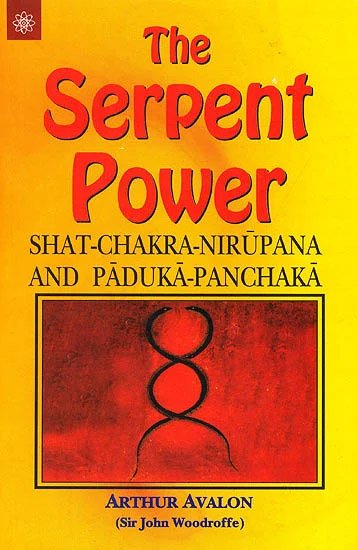Shat-cakra-nirupana (the six bodily centres)
by Arthur Avalon | 1919 | 46,735 words | ISBN-10: 8178223783 | ISBN-13: 9788178223780
This is the English translation of the Shat-cakra-nirupana, or “description of the six centres”, representing an ancient book on yoga written in the 16th century by Purnananda from Bengal. This book investigates the six bodily centres famously known as Chakras. The text however actually forms the sixth chapter of the Shri-tattva-cintamani, compiled...
Verse 9
Sanskrit text, Unicode transliteration, Word-for-word and English translation of verse 9:
तन्मध्ये लिङ्गरूपी द्रुत-कनक-कला-कोमलः पश्चिमास्यः
ज्ञानध्यानप्रकाशः प्रथमकिसलयाकाररूपः स्वयम्भुः ।
विद्युत्पूर्णेण्डुबिंब-प्रकर-करचय-स्निग्ध-संतानहासी
आशीवासि विलासी विलसति सरिदावर्तरूपप्रकारः ॥ ९ ॥tanmadhye liṅgarūpī druta-kanaka-kalā-komalaḥ paścimāsyaḥ
jñānadhyānaprakāśaḥ prathamakisalayākārarūpaḥ svayambhuḥ |
vidyutpūrṇeṇḍubiṃba-prakara-karacaya-snigdha-saṃtānahāsī
āśīvāsi vilāsī vilasati saridāvartarūpaprakāraḥ || 9 ||Inside it (the triangle) is Svayaṃbhu[1] in His Liṅga-form,[2] beautiful like molten gold, with His head downwards. He is revealed by Knowledge[3] and Meditation,[4] and is of the shape and colour of a new leaf. As the cool rays of lightning and of the full moon charm, so does His beauty. The Deva who resides happily here as in Kāśī is in forms like a whirlpool.[5]
Commentary by Śrī-Kālīcaraṇa:
In this verse he speaks of the presence of the Svayaṃbhu-Liṅga in the triangle.
“Svayaṃbhu in his Liṅga-form” (Liṅga-rūpī svayaṃbhu)—i.e., here dwells the Śiva-Liṅga whose name is Svayaṃbhu.
“Beautiful like molten gold” (Druta-kanaka-kalā-komala).—His body has the soft lustre of molten gold.
“His head downwards” (Paścimāsya).—Cf. Kālī-kulāmṛta: “There is placed the great Liṅga Svayaṃbhu, who is ever blissful, his head downward, active when moved by Kāma-Bīja.”
“Revealed by Knowledge and Meditation,” (Jñāna-dhyāna-prakāśa).—Whose existence is apprehended by us by Knowledge (Jñāna) and Meditation (Dhyāna). By Jñāna we realize the attributelessness and by Dhyāna the attributefulness (of the Brahman). Such is Svayaṃbhu.
“The shape and colour of new leaves” (Prathama-kisalayā-kāra-rūpa).—By this is conveyed the idea that the shape of the Svayaṃbhū-Liṅga is tapering like a new unopened leaf-bud. Like the pistil inside the Caṃpaka flower, it is broad at the bottom and tapers to a point at the end; this also shows that the Svayaṃbhu-Liṅga is of a blue-green colour (Śyāma).
Cf. Śāktānanda-taraṅginī: “O Maheśāni, meditate inside it (the triangle) upon the Svayṃbhu-Liṅga, who holds his head with an aperture therein downward—the beautiful and blue-green Śiva (Śivaṃ Śyāmala- sundaraṃ).”
In the Yāmala occurs the following passage: “Meditate upon the very beautiful celestial triangle (Trikoṇa) in the Mūlādhāra; within its three lines is Kuṇḍalī, charming like ten million lightning flashes in the dark blue[6] clouds.”
This passage, which describes Kuṇḍalī as “lightning in the dark blue clouds,” goes to show that the Svayamṃbhu-Liṅga is also blue; but Nila (blue) and Śyāma (dark green) belong to the same category, and hence there is no contradiction.
As the cool rays of lightning and of the full moon charm, so does His beauty” (Vidyut-pūrṇeṇḍu-biṃba-prakarakara[7]-caya-snigdha-saṃtāna-hāsī).—As the strong light of the moon and of lightning emits no heat, so is the light which emanates from the Svayaṃbhu-Liṅga cool and pleasing bringing gladness into the hearts of men.
“The Deva who resides happily here as in Kāśī”[8] (Kāśī-vāsi-vilāsī). Kāśī is the place sacred to Śiva, His favourite abode. By these two adjectives it is implied that the Svayaṃbhu in the Ādhāra Lotus is happy as He is in His form of Viśveśvara in Kāśī, and He is as pleased to be here as at Kāśī. “Vilāsī” may also mean amorous because it has been said above, “moved by Kāma-Bīja”. Vilāsī is indicative of His Lordship of the Universe.[9]
“Like a whirlpool” (Sarid-āvarta-rūpa-prakāra).—The whirling water on its outer edge creates a depression in the middle and the centre thereof is raised like the shape of a concḥ.[10]
This Svayaṃbhu is placed on the Kāma-bīja. This has been said in Kālī-Kulāmṛta: “Surrounded by the filaments of the lotus, is the Śṛṅgāṭa[11] and over this is the beautiful Mahā-Liṅga Svayaṃbhu, with an opening on the top, ever happy, holding his head downwards, and active when moved by the Kāma-bīja.”
Elsewhere the following occurs: “There, in the pericarp, is the above-mentioned Ḍākinī and the triangle (Trikoṇa) within which is a small aperture and the red Kāma-bīja. There is also the Svayaṃbhu-Liṅga, his head downward and of a ruddy hue.” This is, however, a different conception.
Footnotes and references:
[1]:
“Self-originated,” “self-existent,” the Śiva-Liṅga of that name.
[2]:
As the human phallus.
[3]:
Jñāna.
[4]:
Dhyāna.
[5]:
This refers to a depression on the top of the Liṅga.
[7]:
Viśvanātha for Kara (ray) reads Rasa—that is, the nectar flowing from the Moon.
